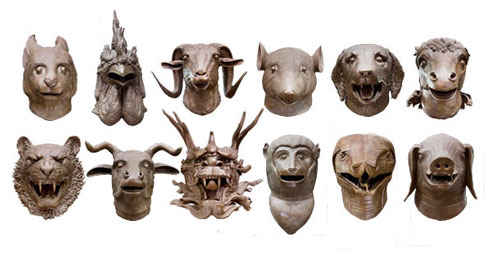
Bronze animal heads created by Ai Weiwei for his upcoming outdoor exhibition, Circle of Animals/Zodiac Heads, May 2-July 15, Grand Army Plaza, New York
[More on this story, here.]
I hope that by the time your read this, Ai Weiwei may have been released and the message of this post will be overtaken by events.
But as I write this late Tuesday night, the detention of the internationally renowned and widely respected artist-provocateur has gone on much too long. (He was taken into custody on Sunday.) Our worst fears about the significance of his disappearance have now been explicitly stated in a Financial Times article, published earlier today and picked up by the Washington Post‘s website this evening.
Jamil Anderlini writes from Beijing:
Human rights groups say Ai is in grave danger of being tortured and is probably being deprived of medicines he needs regularly….
Although Mr Ai has had numerous run-ins with China’s state security apparatus because of his vociferous and often cleverly satirical attacks on one-party Communist rule, he has never been formally
detained or disappeared in this way before.
Museum officials and other artworld luminaries must join government officials from Germany, France, Austria, Great Britain, the European Union and the United States in raising their voices in protest Ai’s continued, unexplained detention. His treatment by the authorities is not only unconscionable but also a violation of Chinese law (as noted by Jeremy Page, reporting from Beijing for the Wall Street Journal).
The time has come to raise the public’s consciousness about Ai’s plight and to send a clear, forceful message to the Chinese government, even if those authorities choose to ignore outside pressure.
How to accomplish this? Melissa Chiu, director of Asia Society Museum in New York, has pointed a way: In a statement linked from her institution’s homepage—Ai Weiwei: From Porcelain Seeds to Chinese Prison?—Chiu asks, “Will the Chinese government make Ai Weiwei into the next Liu Xiaobo? (Liu was honored with last year’s Nobel Peace Prize while incarcerated in China. But even that kind of international pressure did not alter his fate.)
While Chiu’s expression of support for Ai is mildly worded, at least it’s a start. Every museum in this country that displays Chinese art (and even those that don’t) should prominently post an online statement deploring Ai’s confinement and demanding his immediate release. What’s more, a placard with his picture and a description of his dire predicament should be stationed at the entrances to galleries displaying Chinese art, PARTICULARLY if that art has been loaned to the U.S. by China. If China refuses to allow the continued display of its works under those circumstances, so be it.
There are two such Chinese loan shows now in New York that immediately come to mind: Along the Yangzi River: Regional Culture of the Bronze Age from Hunan at the China Institute, and, of course, The Emperor’s Private Paradise: Treasures from the Forbidden City at the Metropolitan Museum (reviewed by me here).
As you may remember, in the wake of the recent Egyptian uprising, when the news spread about widespread looting of Egyptian archaeological sites, the Met’s director, Thomas Campbell, declared:
The world cannot sit by [emphasis added] and permit
unchecked anarchy to jeopardize the cultural heritage of one of the
world’s oldest, greatest, and most inspiring civilizations.
That wording should now be applied to one of the world’s greatest and most inspiring artists. Campbell and other museum directors (perhaps through AAMD, their professional association) should declare that “the world cannot sit by and permit” the continued unexplained, possibly injurious detention by China of its best known and internationally admired contemporary artist.
A particular focal point for the American artworld’s protest should be the upcoming outdoor exhibition of Ai’s work at New York’s prominently situated Pulitzer Fountain in Grand Army Plaza (adjoining the southeast corner of Central Park). The display consists of 12 bronze animal heads and Ai’s attendance at next month’s opening had been anticipated. The sculptures represent the traditional Chinese zodiac and are based on the heads that once adorned the fountain-clock of the Qianlong Emperor’s Summer Palace.
This exhibition should not merely be “moving ahead in the same way that we started,” as Chinese art collector Larry Warsh, one of the show’s organizers (as founder of AW Asia, a group promoting Chinese contemporary art), told Robin Pogrebin of the NY Times.The Ai-enhanced Pulitzer Fountain should now be reconceived as a venue for demanding Chinese human rights in general and Ai’s release in particular.
Perhaps the extremely moving video below should be screened at Grand Army Plaza, in the artist’s absence, and at museums in this country and abroad. It contains excerpts from a conversation aired this evening on HDNet, in what is billed as “one of the last television interviews that Ai Weiwei conducted before his detention on Sunday morning at Beijing Capital Airport”:
Klayman also published this commentary on the Huffington Post.
